Yes there is.
Here is my strong recommendation for you guys to learn to use Wisc. Fish - tons of info.
Common Pond Q&A (archives) » Links to Identification Sites
http://www.pondboss.com/cgi-bin/ubbcgi/ultimatebb.cgi?ubb=get_topic;f=22;t=000021 Wisc. Fish ID
http://wiscfish.org From Wisc. Fish ID system. You can take this info or better yet download the software and look at all the pics and descriptions etc.
http://wiscfish.org/ Great site - Here is an example :
GSF
Mouth and snout: Mouth Terminal, large and oblique, with pads of small teeth on the jaws. No barbels. Body patterning, color, and scales: Back dark brown, olive, or green, sides yellow-green or blue-green, belly tan or yellow. Sides either with a more-or-less solid color, faint dark blotches or mottling, irregular faint light blue or yellowish SPOTS, and/or diffuse dark vertical bars. Sometimes 3-5 bluish lines radiating backward from underneath the eye; opercular flap dark with a light margin. Dorsal, caudal, and to a lesser extent anal fins usually darkly pigmented with faint dark blotches or light dark spots and often a light yellow/cream margin; pelvic and pectoral fins lightly pigmented to dusky. 44-51 ctenoid lateral scales. Body shape and size: Body laterally compressed and deep, somewhat elongated; oval in cross section. Typically 75-150 mm (3-6 in) TL; maximum in Wisconsin about 250 mm (10 in).
Tail, dorsal and other fins: Slightly Forked or round tail. Dorsal fin with 2 lobes, broadly joined by a membrane and appearing as one fin, the first with 9-11 spines and the second with 10-12 rays. Pelvic fins thoracic. Adipose fin absent. Anal fin with 3 spines and 9-10 rays.
GSF There are 9-12 short and thick primary gill rakers on the 1st arch.
BG
BG There are 13-16 moderately long primary gill rakers on the 1st arch.
HBG
Hybrid of green sunfish X bluegill: Notice intermediate appearance of gill rakers
Let us know what you see and find out.
These should help
GSF
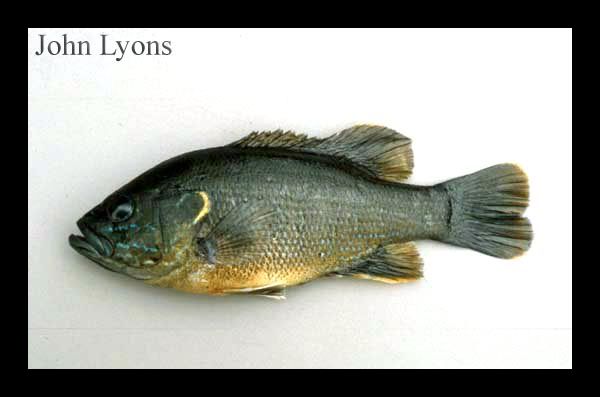
GSF gill rakers

HBG
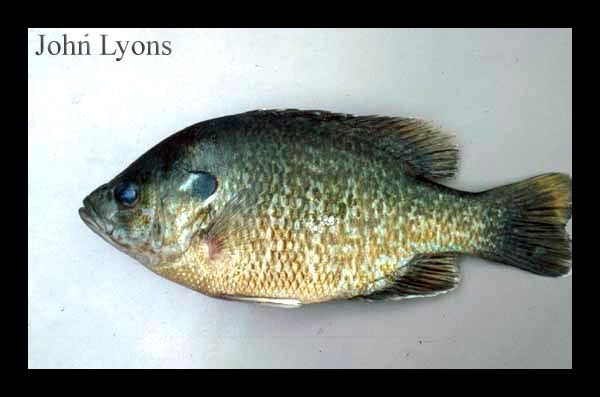
HBG (Bg x GSF) gill rakers
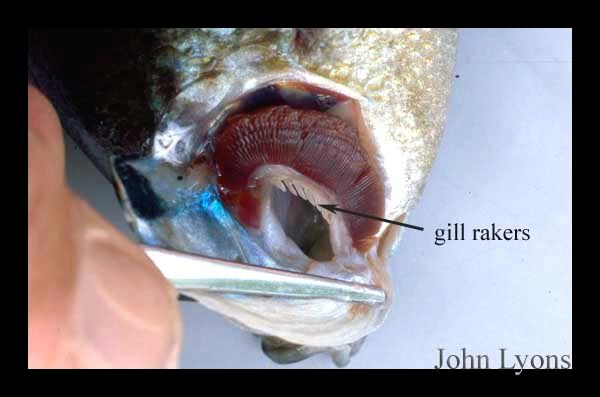
Common Name: Scientific Name: Family Name:
Bluegill Lepomis macrochirus Sunfishes (Centrarchidae)
Attribute category Attribute Description
Adult Views no data
Other Views no data
Body Mouth and snout: Mouth terminal, relatively small and oblique, with pads of small teeth on the jaws. No barbels. Body patterning, color, and scales: Black olive brown, sides dark or silver-blue or bluish-olive, belly cream or yellow-orange. Sides usually solid color, often overlain with faint diffuse vertical bars. Opercular flap solid dark blue. Dorsal, caudal, and to a lesser extent anal fins usually a darkly pigmented solid color; the soft dorsal often has a large diffuse blotch at its base. The pelvic and pectoral fins are lightly pigmented to dusky. 39-45 ctenoid lateral scales. Body shape and size: Body laterally compressed and deep; oval in cross section. Typically 150-225 mm (5-9 in) TL; maximum in Wisconsin about 300 mm (12 in).
Fins Tail, dorsal and other fins: Slightly forked or round tail. Dorsal fin with 2 lobes, broadly joined by a membrane and appearing as one fin, the first with about 10 spines and the second with 10-12 rays. Pelvic fins thoracic. Adipose fin absent. Anal fin with 3 spines and 10-12 rays.
Distinguishing Characteristics See similar species information.
Breeding Adults Similar to non-breeders, but with more intense colors (esp. dark blue body, orange belly, dark opercular flap).
Juveniles Similar to adults, but spots and colors less intense, more silvery, usually without vertical bars.
Miscellaneous no data
Hybrids All Lepomis species in Wisconsin have the potential to hybridize with each other, and certain combinations are relatively common.
BG gill rakers
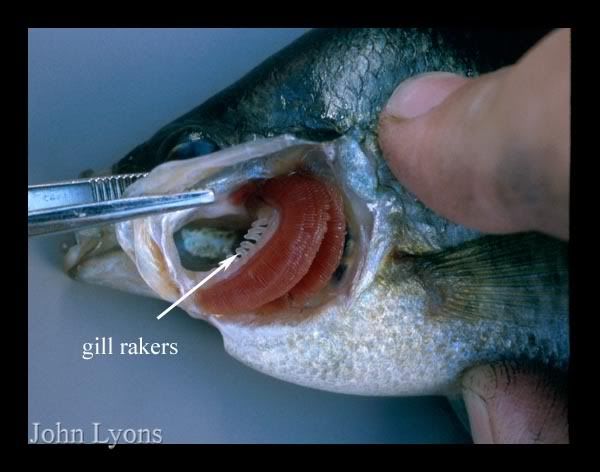
Other type info
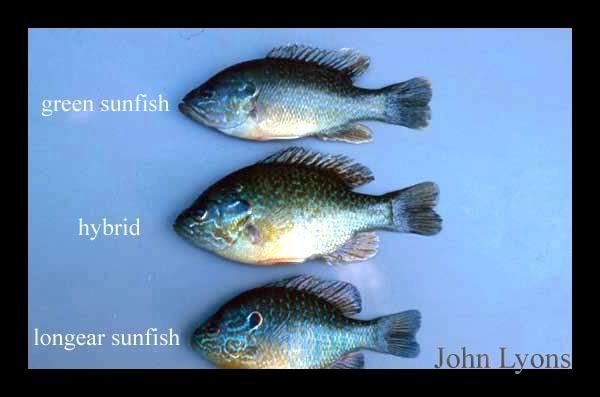
A warning though , as Bill notes (check the morphological features) don't rely on appearance alone. This from Dave Willis is an indication of how far off we can be base on looks alone - "The last time up there, I grabbed what appeared to be a parental male bluegill to show a student the long gill rakers, and it had short stubby rakers (i.e., green sunfish gill rakers!). As a result, I really can't tell how much reproduction comes from supposed parentals and how much from the hybrid swarm. This lake has had the hybrids for decades."